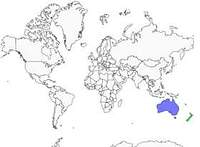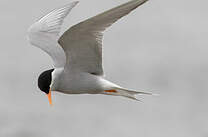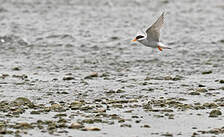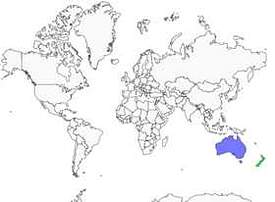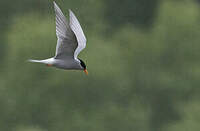Black-fronted Tern
Chlidonias albostriatus - Guifette des galets
Identification
This species is sometimes considered to belong to the genus Sterna (Sterna albostriata). Quite similar to the Whiskered Tern (Chlidonias hybridus). Upperparts and back uniformly dark grey, white rump (grey in Whiskered Tern), outer rectrices pale grey. Black forehead extending from the bill to the nape, just beneath the eye. White cheeks contrasting with the grey throat and flanks, as well as the belly and breast. Bill and legs reddish. Legs are short. Forked tail. In non-breeding adults, the forehead is much paler and only extends from one eye to the other, and the bill tip is black.Juveniles are quite similar, but the bill is more of a dull orange than red, and the black extends further onto the tip.
Subspecific information monotypic species
Foreign names
- Guifette des galets,
- Fumarel maorí,
- gaivina-de-testa-preta,
- Graubauch-Seeschwalbe,
- feketefejű szerkő,
- Nieuw-Zeelandse Stern,
- Sterna frontenera,
- maoritärna,
- Maoriterne,
- čorík čiernočelý,
- rybák novozélandský,
- Maoriterne,
- uudenseelannintiira,
- xatrac de Nova Zelanda,
- rybitwa czarnoczelna,
- Чернолобая крачка,
- クロビタイアジサシ,
- 黑额燕鸥,
- maoritärna,
- 黑額燕鷗,
Habitat
Endemic to New Zealand, the Black-fronted Tern breeds exclusively on the South Island, east of the Central Range. During the breeding season, it is almost exclusively encountered on inland waters, notably rivers featuring wide stretches of gravel islands. In winter, it moves to the coast and feeds in the sea.
Behaviour character trait
In winter, parts of the population migrate towards the Northern Island where they frequent the eastern coast. The Black-fronted Tern used to nest in this island. It is often observed flying above wet meadows and even pastures and mowed meadows. It collects its prey at the surface of the water or on the ground, and can also dive and capture insects in flight. During reproduction, adults attack violently any intruder.
Dietfeeding habits
Reproduction nesting
Threats - protection
IUCN conservation status
concern
in the Wild
threatened
evaluated
The Black-fronted Tern was classified as 'endangered' in 2004 by BirdLife International and is listed as 'vulnerable' on IUCN's Red List in 2006. The population estimates vary greatly from author to author. The most recent estimates range from 7,000 to 10,000 individuals or 1,000 to 5,000 pairs. The main threats facing this species are predation from introduced mammals, particularly Mustelids, Rats and Cats, trampling of colonies by livestock, invasion of its gravel islands by exotic vegetation, development of water sports and changes in waterways for either electricity production or irrigation.
Sources of information
- IOC World Bird List (v15.1), Gill, F and D Donsker (Eds). 2025-12-07.
Other sources of interest
 Specification sheet created on
02/08/2023 by Georges Olioso
Specification sheet created on
02/08/2023 by Georges OliosoTranslation by AI Oiseaux.net
© 1996-2025 Oiseaux.net
- Accipitriformes
- Aegotheliformes
- Anseriformes
- Apodiformes
- Apterygiformes
- Bucerotiformes
- Caprimulgiformes
- Cariamiformes
- Casuariiformes
- Charadriiformes
- Ciconiiformes
- Coliiformes
- Columbiformes
- Coraciiformes
- Cuculiformes
- Eurypygiformes
- Falconiformes
- Galliformes
- Gaviiformes
- Gruiformes
- Leptosomiformes
- Mesitornithiformes
- Musophagiformes
- Nyctibiiformes
- Opisthocomiformes
- Otidiformes
- Passeriformes
- Pelecaniformes
- Phaethontiformes
- Phoenicopteriformes
- Piciformes
- Podargiformes
- Podicipediformes
- Procellariiformes
- Psittaciformes
- Pterocliformes
- Rheiformes
- Sphenisciformes
- Steatornithiformes
- Strigiformes
- Struthioniformes
- Suliformes
- Tinamiformes
- Trogoniformes


